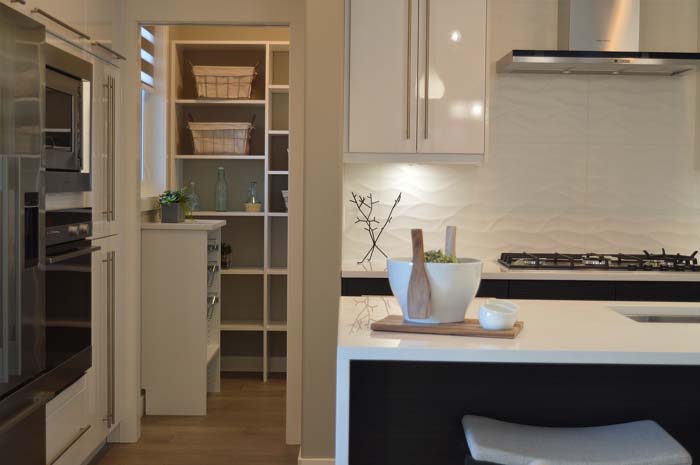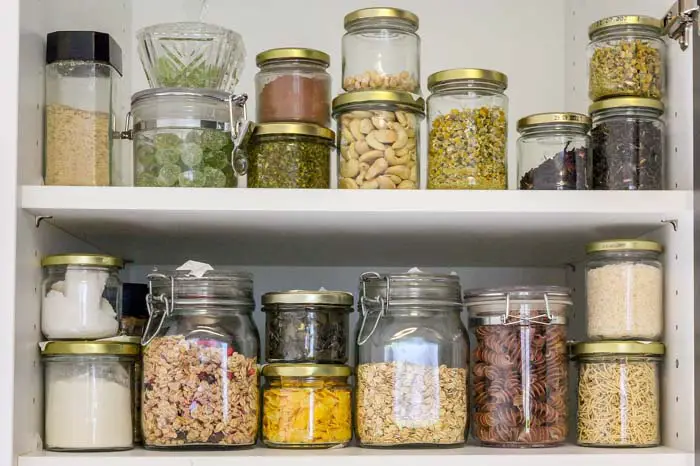A home kitchen pantry is a major factor in many people’s decisions to remodel their kitchens in the first place. When it comes to these homeowners, upgrading the kitchen is about expanding the area.
It’s not like you’re actually expanding your kitchen or building a new extension until you’re doing so. Instead, you’re maximizing the space that’s already there. Adding a pantry to your kitchen is a great way to make the most of your available storage space.
In the kitchen, what is a “pantry?”
Non-perishable food items, including bagged or boxed food, dried pasta, canned goods, and oils, are commonly kept in kitchen pantries. It is also possible to store food prep things like parchment and foil in the pantry along with other serving ware and pans.
You can store root vegetables like onions and potatoes in home kitchen pantries because they are usually enclosed. Remember to store china, stemware, plates, and glassware in larger kitchen pantries.
What to look for when purchasing a kitchen pantry
-
Features
The organization of your pantry while cooking is made easier by adding extra features. A variety of options are available for storing spices, such as drawers and baskets, pull-down shelving, bigger cubbies, revolving/swivel trays, or spices. Additionally, you can use them to hold bulkier goods like small appliances. Find out if your new pantry has any specific features you’d enjoy.
-
Style
The style of your kitchen pantry should match or complement the style of your kitchen cabinets. You do not want to put it in a traditional or modern pantry with traditional cabinets.
You should match the color as closely as possible, just as you would the style. A pantry option may be available from the maker of your current cabinets, especially if they are relatively recent.
-
Space
It is important that you measure the kitchen pantry area before you go shopping. You’ll be able to know how much room you have for one. Knowing the room’s dimensions is good when looking for a kitchen pantry.
Consider the amount of room you have to work with when deciding whether or not to use a sliding, folding, or swinging door. You might not have enough space for an outward-opening door because it would obstruct traffic or wouldn’t open all the way. Some people prefer a pantry with no door and an open shelf because it is more convenient and accessible.
Kinds of Kitchen Pantries

It’s impossible to stress the importance of keeping a well-stocked kitchen pantry. In order to keep a kitchen free of clutter and running smoothly, this is one of the most effective methods. The floor plan will primarily determine the type of kitchen pantry you choose and the layout. It will also depend on the amount of space available in your kitchen or surrounding rooms. There are many different kinds of pantries. For your convenience, we’ve listed some of the most common types of kitchen pantries.
Built-In Cabinet Pantry
If you’re looking to add some more storage space to your kitchen, you may want to consider a built-in cabinet pantry. These offer you an opportunity to make a unique kitchen feature that accentuates the design style and arrangement of this part of your home.
These custom built-in cabinet pantries are available in various layouts and styles. Permanent pantry cabinets like these are a great way to keep a kitchen clean and improve its appearance.
Freestanding Pantry
It is possible to use a freestanding pantry as furniture in the kitchen. They provide storage and allow for customization in the pantry’s location. It’s an excellent alternative if you don’t want a built-in pantry or a separate kitchen pantry room but still need more storage space.
It is possible to create freestanding pantries that match the cabinetry in the kitchen or provide a vivid splash of color in your room. Freestanding pantry configurations can also be tailored to match your requirements. You can find additional storage solutions in the form of custom doors, shelves, drawers, and much more.
Butler’s Pantry
Having a butler’s pantry comes with numerous advantages. Butler’s pantries have long served as a space where guests’ food and cooking equipment may be safely stored and prepared out of sight. A butler’s pantry in your home can provide similar advantages.
The purpose of a butler’s pantry is to give additional storage in the form of cabinets and a work surface. If you party frequently and often need additional space to prepare meals for large groups of people, this can be a useful addition to your kitchen. Even if this isn’t the case, adding a butler’s pantry to your home can improve your kitchen storage space while adding an eye-catching feature to your property.
Slide-Out Pantry
Using slide-out pantries in a kitchen is a creative way to save space. They might be very beneficial in situations where space is at a premium. It is possible to construct and incorporate slide-out pantries into the kitchen cabinetry.
As a result, they fit seamlessly into the overall kitchen design. The quantity of storage capacity they offer is significantly greater than expected. Revolving doors and sliding shelves can give adequate storage space. They will also make it easy to see access and store kitchen items.
Walk-In Pantry
The best choice of kitchen pantry is a walk-in pantry. There are advantages and disadvantages to having a walk-in pantry. Because they require a certain amount of pantry space, they may not be the best option for every kitchen. On the other hand, a walk-in pantry has numerous advantages, making it sensible for any floor layout.
Walk-in pantries, which serve as an extension of the kitchen or a separate room, offer a surprisingly significant amount of storage for a very small footprint. A walk-in pantry’s shelving design and arrangement can make storing non-perishable foods and other kitchen supplies easier. For this reason, it may be worth considering for even those with smaller households.
Wall Pantry
To maximize storage space in the kitchen, consider a wall pantry, which utilizes space that would otherwise go to waste. As the name implies, a wall pantry is built into the kitchen wall. This type of pantry will take up valuable wall space that you can use for other purposes, such as cabinets.
This pantry can be an excellent use of space and provide the enormous storage capacity that is neatly hidden behind closed doors in a kitchen plan that allows for it. This pantry’s doors can blend in with the rest of the wall in subtle ways.
Organizing Your Pantry
-
Pulling everything out
Remove everything from your pantry and clean it before you start arranging. Throw out anything that’s expired.
-
Group similar items together
After emptying your cupboard of all its contents, organize your food into categories such as snacks, pasta, and baking. The idea is to combine similar items, like flour and sugar, pasta sauce, and pasta, so they are easier to find when needed.
-
Making a list
List everything you own and store it in your pantry for easy access. Moving ahead, you can add or subtract from this.
-
First in, first out storage
You can place the older products in the back and the newer ones in the front. This will allow you to use the older items first and finish them before they go bad. Your refrigerator is in the same boat. Preparing and storing fresh vegetables and fruits near the front of the refrigerator will make them easier to find.
-
Identify and date the product
You should label the containers and date them as soon as possible. If you have a lot of bulky things in your cupboards, such as pasta and flour, you may want to keep track of their expiration dates.
-
Place daily objects on hand
Aim for the highest or lowest shelves for products you use on a daily basis and the highest or lowest shelves for items you rarely use. To make it easier for your kids to get healthy food, put it on the bottom shelf and the occasional treat on the top.
-
Check-in once a week
Anything with a door, such as closets, refrigerators, and pantries, is a prime candidate for allowing clutter to accumulate. Once a week, make a point of checking in to make sure everything is still where it should be. Also, make a list of what you already have and what you might want to acquire. Spending a few minutes now will pay dividends in the long run.
Having a Well-Organized Pantry Has Many Advantages
-
Eating healthily is a good thing:
Fresh veggies and fruits should be near the front of the fridge so that your family is more likely to eat them. You can store healthy snacks such as unsweetened dried fruits, seeds, and unsalted nuts in the cupboard for quick and easy access.
-
Decreases waste:
You won’t have to toss out expired things because you’ll use them before they go bad.
-
Stress reduction:
The frustration of going through your cabinet and switching things around and still being unable to locate a food item may be quite unpleasant.
-
Saves time:
Make a grocery list to know exactly what you need at the supermarket and what you can use in your cooking. This will save time and money.
-
Saves money:
Knowing what you already have will help you avoid buying food you don’t need.
Conclusion
Your kitchen will be more functional with any pantry, no matter which one you choose for your new home. Adding a pantry to your kitchen design is a terrific way to increase storage space. When making your kitchen more user-friendly, pantry storage is a great option. This is an important feature to keep in mind when you begin the design process for your new home.

